The HSA Rescue Sled: A Crucial Tool in Watersports Safety
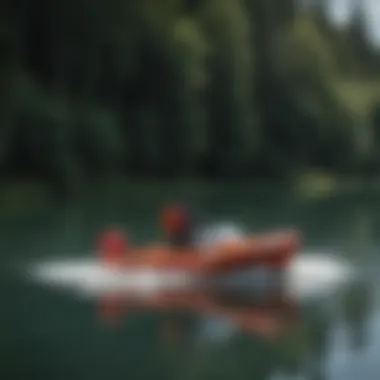

Intro
In the world of watersports, safety often takes a backseat to thrill and excitement, but the reality is starkly different. As adrenalin junkies navigate waves and whirlpools, the unseen dangers can lurk beneath the surface. One of the unsung heroes of aquatic safety is the HSA rescue sled. This piece of equipment has rapidly gained a reputation for its effectiveness in rescue operations. Not just any kind of sled, the HSA design is tailored to facilitate swift and safe rescues, becoming crucial for both professionals and amateur enthusiasts.
Through this article, we will dive into various dimensions of the HSA rescue sled, ranging from its design and functionality to real-world applications in diverse aquatic environments. Additionally, we will look at the materials that make it stand out and the essential training required for its effective use. By the end of our exploration, readers will appreciate not only the importance of the sled itself but also the broader context of safety protocols in watersports that can potentially save lives.
Techniques and Skills
Essential Techniques for Beginners
Gaining proficiency in using the HSA rescue sled encompasses more than just knowing how to paddle. Beginners need certain core techniques to ensure they operate effectively and confidently.
First and foremost, familiarization with basic maneuvers is essential. This includes:
- Launching the sled smoothly from the shore or another vessel, ensuring it stays parallel to the waves to avoid capsizing.
- Navigating through various water conditions, especially choppy waters, requires an understanding of wave patterns. Strength and timing in paddling help in keeping a steady course.
- Learning how to approach a distressed swimmer can make all the difference; quick awareness and positioning are crucial for an effective rescue.
- Lastly, practicing proper communication skills helps both the rescue team and those in distress to remain calm in potentially high-stress situations.
Mastering these techniques sets a solid foundation for beginners to expand their skills and handle more complex scenarios.
Advanced Skills for Experienced Watersport Enthusiasts
For the seasoned watersport aficionado, the HSA rescue sled presents opportunities to refine and enhance skills beyond the basics. Here, it’s about blending strategy with execution. Advanced skills include:
- Tactical positioning, where an understanding of environmental cues can drastically improve rescue efficiency. Knowing when to wait for calmer waters instead of charging in can be critical.
- Teamwork plays a vital role in advanced rescue operations; practicing coordinated rescues where multiple sleds and personnel are involved enhances overall safety and efficacy.
- Responding in adverse conditions necessitates rigorous training. Knowledge of how heavy winds or rough seas affect the sled's movement is a valuable asset.
- Finally, developing scenario-based drills, practicing different emergency situations beforehand, ensures that both psychological readiness and skill level are at peak performance.
By honing these advanced techniques, experienced enthusiasts can not only safeguard their passions but also those of others, turning the thrill of watersports into a safer adventure.
Equipment and Gear
Must-Have Gear for Each Watersport
While the HSA rescue sled steals the limelight in safety discussions, appropriate gear is paramount for any watersport enthusiast. Below are essential items that should accompany the sled in different watersport activities:
- Personal flotation devices (PFDs) - Always wear one. This cannot be stressed enough.
- Wetsuits or drysuits - Depending on water temperature, adequate exposure protection is imperative.
- Communication devices - Waterproof radios or even a whistle enhance safety during rescue operations.
- Rescue throws - An airbag or rescue rope can be a lifesaver in quick response situations.
Tips for Selecting the Right Equipment
When selecting equipment for your watersport endeavors, keep the following in mind:
- Quality over quantity - Invest in fewer but higher-quality items that can withstand tough conditions.
- Know your environment - Different watersports may require varied equipment. Research the specific requirements based on activities.
- Fit matters - Ensure that gear is comfortable and properly fitted. A poor fit can lead to accidents.
- Budget wisely - Be on the lookout for equipment that balances affordability and functionality without compromising safety standards.
As watersport enthusiasts, the responsibility falls on each of us to prioritize safety while enjoying pursuits on the water. Knowing how to use the HSA rescue sled effectively and choosing the right equipment leads to a more enjoyable and safe experience.
Preamble to HSA Rescue Sled
The significance of the HSA rescue sled in the world of watersports cannot be overstated. As individuals engage in various aquatic activities, the possibility of accidents increases. In this context, having reliable rescue equipment becomes crucial. The HSA rescue sled stands out not just for its design, but for its role in ensuring safety and efficiency during rescue operations. Its incorporation into training protocols and its practical application have given it a prominent place in the toolkit of many instructors and rescue personnel.
Definition and Purpose
An HSA rescue sled is a life-saving device specifically designed for use in aquatic environments. Its primary purpose is to facilitate the safe and efficient retrieval of individuals in distress, whether they are swimmers caught in currents or participants in extreme watersports experiencing emergencies. The sled is constructed to float easily on the water surface while providing a stable platform for rescuers to maneuver and assist victims.
Key Features of HSA Rescue Sleds:
- Buoyancy: Makes it easy to spot and retrieve from a distance.
- Stable Design: Allows for confident handling in turbulent waters.
- Versatile Usage: Suitable for various bodies of water, including lakes, rivers, and oceans.
A sled in rescue operations simplifies the process of getting individuals out of the water and back to safety quickly.
Historical Context
The origins of rescue sleds trace back several decades, evolving with advancements in technology and design principles. Initially, simple canvas contraptions were employed, but with time, manufacturers began to focus on creating sleds with better flotation and maneuverability. Maritime agencies and rescue teams have continually refined their designs to meet the changing needs of rescue professionals.
The HSA rescue sled, in particular, was developed in response to the urgent need for reliable aquatic rescue tools as watersports gained popularity. It integrates features that are informed by real-world rescue operations and feedback from professionals in the field. Historical incidents have prompted the need for enhanced safety measures, leading to innovations in sled design that address various aquatic challenges.
"Safety doesn't happen by accident; it is built into the equipment we use and the training we give."
Through careful analysis of past incidents and ongoing training standards, the HSA rescue sled remains a testament to how equipment can evolve to meet the urgent demands of watersport safety. Its unique blend of functionality and historical insights makes it an indispensable resource for anyone committed to aquatic safety.
Design Characteristics
The design characteristics of the HSA rescue sled are pivotal for effective usage in aquatic rescue scenarios. Understanding these traits can significantly impact the performance of rescue operations while ensuring the safety of both the rescuer and the person in distress. Several elements combine to create a sleigh that can endure the rigors of watersports environments, ultimately contributing to swift and efficient rescues.
Material Composition
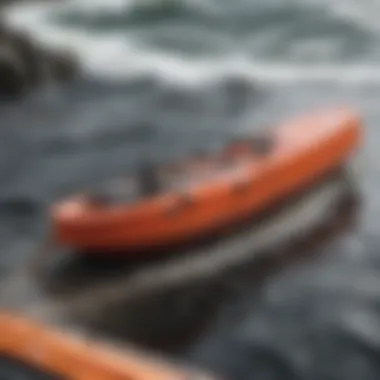
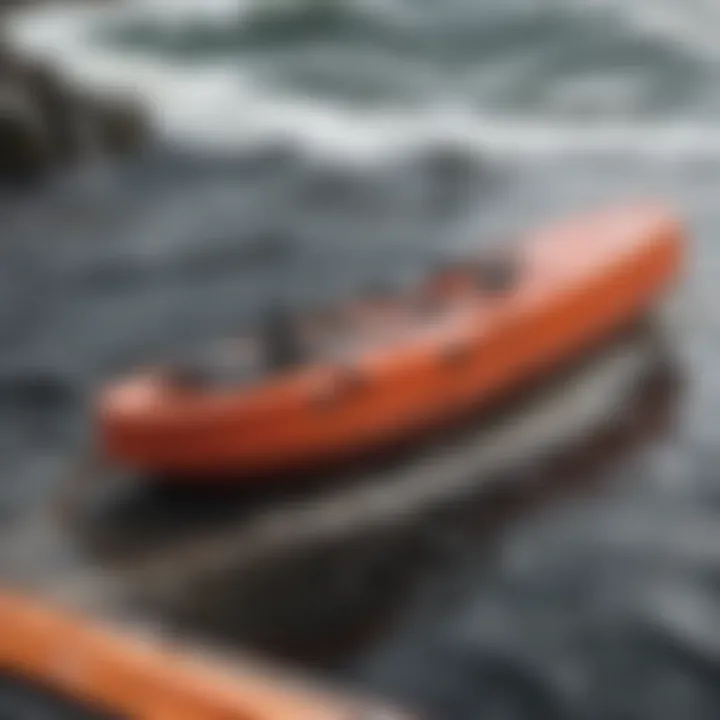
The choice of materials plays a crucial role in the performance and durability of the HSA rescue sled. Most commonly, materials like high-density polyethylene are preferred due to their robust nature and resistance to harsh marine conditions. This resilience means that the sled won't easily warp, crack, or become damaged, even when exposed to saltwater or UV rays.
Moreover, the sled's lightweight nature allows for easier handling during emergency situations, which is critical when time is not on your side. When designed thoughtfully, the material should offer a balance between strength and weight—without a doubt, a heavy sled is a drag when speed counts.
"Quality materials not only improve functionality but also provide peace of mind during rescue operations."
Structural Features
Structural features of the HSA rescue sled are carefully engineered to enhance its effectiveness. One of the notable aspects is the streamlined shape, designed for optimal buoyancy and swift movement through water. This design reduces drag, allowing rescuers to glide over waves rather than fighting against them, thereby increasing their speed.
Further, the incorporation of handles at strategic points on the sled carries significant advantages. Rescuers can grab hold quickly, facilitating ease of use during high-pressure moments. These features can make or break a rescue operation, where each second barbs against the sands of time.
Stability also plays a vital role; many sleds come with a wider base, making them less likely to tip over, especially in rough waters. This stability not only protects the rescue swimmer but also ensures that the individual being rescued remains secure during the process.
Portability and Storage Solutions
When discussing the practicality of the HSA rescue sled, but without a doubt, portability and storage solutions are significant. In many cases, rescues happen in locations that may not have an immediate access to transportation. This is where a sled with features that promote easy folding or disassembly becomes invaluable. An easily transportable sled can be a lifesaver in emergencies, making it simple for team members to pack it into a vehicle or carry it on foot to their destination.
Storage is another point to ponder. A sled designed to fit snugly in tight spaces, whether in a boat or storage room, allows for better preparedness. Many designs offer a clever mechanism for stacking or nesting with similar gear, thus taking minimal space and being readily available when duty calls.
Overall, careful attention to design characteristics such as material composition, structural features, and ease of portability contribute immensely to the sled's efficiency in real-world operations. Understanding these traits is vital for anyone involved in watersports rescue. By investing in a quality-designed sled like the HSA, rescuers enhance their chances of success with each operation.
Functionality in Rescue Operations
When we dive into the essence of watersport rescue, the functionality of the HSA rescue sled stands out. This sled isn't just a piece of equipment; it plays a crucial role in saving lives, ensuring safety, and facilitating smooth rescue operations in a variety of aquatic situations. The important thing here is understanding how it works and the benefits it brings to rescue teams who often face unpredictable circumstances.
Operational Mechanisms
The operational mechanisms of the HSA rescue sled can be likened to a well-oiled machine. Essentially, it employs a simple yet effective design that allows for rapid deployment in emergencies. This sled is built with safety and efficiency in mind.
- Inflatable Design: One of the standout features is its inflatable structure, which allows for buoyancy and stability in turbulent waters. When needed, the sled can be inflated within seconds, making it ready for action.
- Easy Attachments: With quick-release connections, rescuers can easily attach the sled to a personal watercraft or boat. This feature is paramount because in life-or-death scenarios, every second counts.
- Ergonomic Design: It's designed to accommodate varying body types and sizes, ensuring that individuals being rescued can lay comfortably and securely, minimizing movement that could lead to injury.
The sled’s mechanics is straightforward, but it’s this very simplicity that enhances reliability. Knowing that it can be deployed swiftly gives rescuers a significant advantage when every moment matters.
Versatility Across Water Conditions
One of the strong suits of the HSA rescue sled is its versatility, allowing it to perform efficiently in diverse water conditions. This adaptability is vital as rescue situations can emerge in environments ranging from calm lakes to stormy seas.
- Calm Waters: During serene conditions, the sled glides smoothly, offering an easy path for rescuers to approach individuals in trouble. The stability ensures that those being rescued can maintain composure, leading to a successful retrieval.
- Choppy Waves: Conversely, in more tumultuous waters, its design helps to cut through waves, maintaining buoyancy and minimizing the chances of capsizing. It’s this resilience that proves invaluable in critical moments.
- Ice and Cold Water: Some advanced models of the sled are equipped to function even in icy waters, where traditional methods might falter. Rescuers can rely on the sled to provide a stable platform to reach individuals in distress in harsh conditions.
In essence, the HSA rescue sled adapts to the water, not the other way around. It is this ability to function across a range of aquatic scenarios that makes it an indispensable tool for rescue operations.
"The right equipment can be the difference between hope and despair in rescue operations. The HSA rescue sled embodies that principle."
As we delve deeper into the other aspects of the HSA rescue sled, it's essential to keep in mind how its functionality in diverse scenarios increases the odds of successful rescues. Sequential operations rely heavily on equipment that assures stability, efficiency, and safety, and the HSA sled delivers on all counts.
Safety Protocols and Best Practices
In the realm of watersports, safety is paramount. The practices surrounding the HSA rescue sled are no exception. Establishing solid safety protocols not only protects the life of those in distress but ensures the effectiveness of rescuers. In this section, we will cover three essential components of rescue operations while utilizing the sled: pre-rescue preparation, execution of key procedures, and post-rescue considerations. Each of these plays a vital role in achieving optimal outcomes during rescue missions.
Pre-Rescue Preparation
Preparation sets the foundation for successful rescue operations. Before heading out onto the water, it’s important to ensure that both equipment and personnel are ready. This includes:
- Equipment Check: Inspect the HSA rescue sled for any visible wear or damage, ensuring that it’s in perfect working condition. This means looking for leaks or abrasions in the sled's material, which could compromise its buoyancy and structural integrity.
- Knowledge and Communication: All team members must be aware of the plan and understand their specific roles. Conduct briefings where responsibilities are clearly outlined. This conversation can save precious minutes when seconds count.
- Safety Gear for Rescuers: Ensure that each member of the rescue team is equipped with appropriate personal flotation devices, signaling devices, and first aid kits. These items can be invaluable during a rescue.
By conducting thorough pre-rescue preparations, teams can significantly enhance their chances of a successful and safe operation.
Execution of Rescue Procedures
When it’s time to execute a rescue, adhering to established protocols can make all the difference. Here’s how to approach this critical phase:
- Assess the Situation: Before launching the sled, evaluate the conditions. Factors like wave height, current strength, and wind speed can reveal potential hazards.
- Approach with Caution: As rescuers approach the person in distress, maintain a calm demeanor. One might think, "The calmer we are, the more the rescued will calm down too." This assists in reducing panic, enabling better cooperation.
- Secure the Individual: Once alongside the stranded person, ensure they are safely secured. Use techniques such as the "throw-and-go" method, tossing a buoy or tether attached to the sled, allowing the person to hold on while being pulled to safety.
Remember that each situation will have unique challenges that require flexibility and adaptability.
Post-Rescue Considerations
After a successful rescue, the operation isn’t over just yet. Post-rescue actions are critical to ensure safety and improve future responses:
- Care for the Rescued Individual: Provide immediate attention to the rescued person, checking for injuries or hypothermia. Gather information on their state to prepare a report.
- Debrief the Team: Conduct a thorough debriefing with all team members. Discuss what went well and what could be improved regarding communication, technique, and equipment usage.
- Documentation: Document the details of the rescue operation. This record can serve as a learning tool and can help refine training programs in the future.
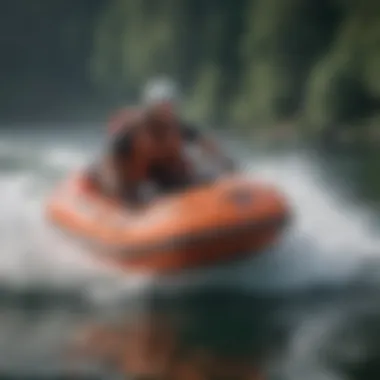
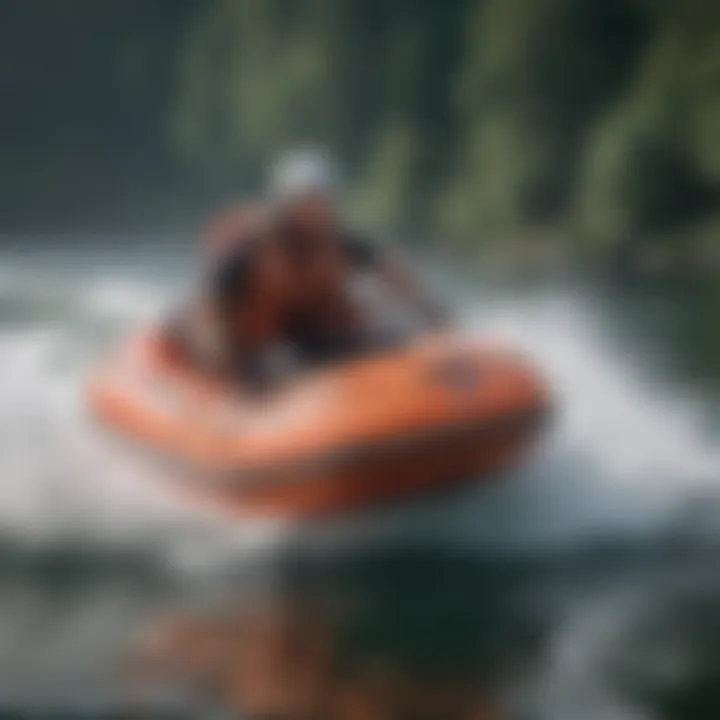
"Preparation breeds confidence. When done right, even the most chaotic rescues can turn into smooth operations."
Implementing robust safety protocols and best practices regarding the HSA rescue sled is absolutely necessary. Each stage—from preparation to debriefing—plays a key part in ensuring the safety of those involved in watersport activities. By following these guidelines, teams can significantly improve their chances of a successful outcome when it matters most.
Case Studies in Utilization
Understanding the practical applications of the HSA rescue sled is vital for appreciating its role in watersports safety. Case studies serve as a lens through which we can examine how this equipment performs in real-world scenarios. Through these examples, we can glean insights on its effectiveness, limitations, and the lessons that enhance its future utilization.
Successful Rescues
Successful rescue operations involving the HSA sled stand as beacons of effective emergency response. One notable case occurred during a regional water sports competition at Lake Algonquin, where high winds and sudden storms posed a significant threat. A participant experiencing fatigue was in distress as conditions worsened rapidly. Rescuers deployed the HSA sled, which enabled them to reach the individual swiftly. The sled, designed for stability, performed without a hitch despite the choppy waters, ensuring the safety of the stranded individual.
Another effective rescue happened along the coast near San Juan during a surfing event. A surfer caught in a rip current was struggling to return to shore. A lifeguard team quickly used the HSA sled, combined with their training in swift water rescue. This showed the sled's adaptability in changing conditions. Within minutes, the surfer was brought back safely, showcasing how timely intervention coupled with reliable equipment can save lives.
These examples illustrate not just success in lives saved, but also highlight the sled's capabilities in variable conditions. It emphasizes the need for training in its use, which ultimately enhances the effectiveness of rescue operations.
"Real-world situations reveal the strengths and weaknesses of any rescue equipment. Lessons learned from actual events contribute greatly to safety improvements and technology advancements."
Lessons Learned from Past Incidents
While successful rescues are worth celebrating, it’s crucial to learn from past experiences. One infamous incident involved a well-publicized rescue operation back in 2019, where an HSA sled malfunctioned during a rescue due to improper maintenance. The issue came to light after a review of the processes led to the discovery that equipment checks had been neglected. Rescuers had failed to inspect the sled's buoyancy features, resulting in a delay during a critical moment.
Another incident unfolded in murky waters. A case in the Gulf of Mexico, where visibility was poor, showcased a moment of miscommunication between the crew and rescuers on board the sled. This led to a less efficient rescue, signifying the importance of clear dialogue. It became apparent that enhanced training focusing not only on equipment handling but also on communication protocols is essential.
Thus, past incidents illuminate significant areas requiring attention:
- Importance of regular maintenance checks to ensure functionality.
- Training opportunities focused on communication and decision-making during rescues.
- Continuous feedback mechanisms for improving protocols based on previous experiences.
These learnings emphasize the necessity for adaptability in training programs and adherence to strict maintenance routines, empowering watersport enthusiasts to prepare adequately for any situation.
Training and Skill Development
When we dig into the heart of watersport safety, one can’t overlook the critical role of training and skill development. The HSA rescue sled, whilst a remarkable piece of equipment, doesn’t operate in a vacuum. Its efficacy hinges not just on its design but on the proficiency of those who wield it. This section delves into the nuances of training and skill development surrounding its use, aiming to shed light on why this area is paramount for ensuring successful rescue operations.
Effective Training Programs
Establishing effective training programs is akin to laying the groundwork for a sturdy house; it’s essential for better performance during high-stakes moments. First off, training is not merely a checkmark on a to-do list; it’s an evolving process.
- Scenario-Based Learning: Simulating real-life rescue situations plays a massive role in these programs. Trainees should engage in practical drills that reinforce their skills under pressure. The more they practice, the more instinctive their reactions will become.
- Skill Variety: A well-rounded program doesn’t just focus on using the sled. It should also cover communication techniques, assessment of water conditions, and first aid. Each aspect intertwines and helps build a competent rescuer who can adapt to dynamic situations.
- Regular Evaluations: Continuous assessments can help identify strengths and weaknesses. Regular feedback loops allow for adjustments in training methodologies. After all, if someone doesn’t know they’re faltering, there’s a good chance they’ll carry those gaps into a rescue scenario.
In essence, effective training programs should be both comprehensive and adaptable, fostering skills that extend beyond merely operating the sled.
Certification and Qualification Standards
This brings us to another pivotal element of training related to the HSA rescue sled: certification and qualification standards. These aren’t just bureaucratic red tape; instead, they act as a safety net, ensuring that both instructors and trainees meet specified capabilities.
- National Certification: Many countries require certifications from recognized bodies like the American Red Cross or equivalent organizations. These certifications typically necessitate a blend of classroom instruction and hands-on training. This two-pronged approach ensures that individuals grasp the theoretical concepts while also honing their practical skills.
- Skill Proficiencies: Each certifying body will have outlined competencies that rescuers must demonstrate. This could range from working effectively with the sled to proper patient handling techniques. Knowing these standards is not just wise; it’s often a prerequisite for professional employment in rescue services.
- Continuing Education: The watersport safety world evolves regularly, with new techniques, equipment, and best practices emerging. Therefore, ongoing education is vital. Professionals in the field should seek to update their certifications regularly, ensuring they're equipped to handle the latest challenges and innovations.
In summary, the importance of training and skill development in the context of the HSA rescue sled cannot be overstated. Effective training programs combined with stringent certification standards lay the backbone for competent rescue operations. For those partaking in watersports, understanding this relationship is crucial to not just personal safety but also the safety of others in challenging aquatic environments.
"Training is not just an investment in skills; it’s a safeguard against the unpredictable nature of water."
As we drive forward, it's essential to keep this in mind; the right training and qualifications can mean the difference between a successful rescue and a tragic outcome.
Comparative Analysis of Rescue Equipment
Examining the HSA rescue sled in the landscape of watersports safety requires diving into the specifics of rescue equipment across the board. This analysis isn't just some academic exercise; it is core to understanding how effective equipment can save lives. By contrasting the HSA rescue sled with both traditional sleds and modern innovations in rescue gear, we can pinpoint the features that make a real difference in emergency situations.
When it comes to rescue operations on the water, the stakes are high. Each piece of equipment has its own set of advantages and challenges. Understanding these distinctions allows rescue teams to choose the right gear for their specific needs, ensuring that they are well-prepared to tackle any situation they might face.
Comparison with Traditional Sleds
Traditional rescue sleds have been long-time staples in the field of aquatic rescue. Typically made from basic materials, these sleds have served their purpose for years. However, they often lack the specialized features needed for today’s diverse and demanding rescue conditions. The comparison reveals several crucial disparities:
- Material Limitations: Most traditional sleds are built from heavier materials that do not handle wear and tear well. This can lead to rapid deterioration when exposed to harsh aquatic environments.
- Functional Design Flaws: Many conventional sleds lack the ergonomic design that newer models like the HSA offer. This can lead to difficulties in maneuvering and utilizing the sled efficiently during rescues.
- Weight Considerations: Traditional sleds can be bulky and cumbersome, making them less portable. This impacts response times in emergency situations where every second counts.
In short, while traditional sleds have a place, they often fall short compared to more modern designs that prioritize both rescue efficacy and user-friendliness.
Innovations in Rescue Gear
The landscape of rescue gear is evolving. Recent innovations have led to the development of equipment that accommodates the latest technology and materials science. Here are key areas where advancements are making waves:
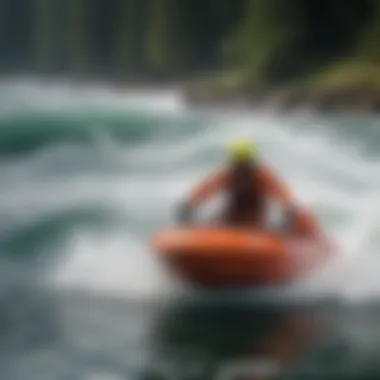

- Lightweight Materials: Modern sleds, such as the HSA, use advanced composite materials that increase durability but decrease weight. This enhances ease of transport and agility in water.
- Enhanced Buoyancy: New designs incorporate improved buoyancy features, allowing the sled to float better and making it easier to carry an individual safely.
- Smart Features: Some rescue gear is beginning to integrate technology such as GPS and emergency communication systems. These additions can significantly improve the effectiveness of rescue missions.
In comparing these innovative options with traditional sleds, it's clear that the evolution of rescue design prioritizes not just performance but also the safety of both the rescuer and the individual in distress.
Considering these elements is vital for sports enthusiasts, adventure seekers, and professionals alike, as they prepare for potential emergencies. Knowing the difference can be the deciding factor between a successful rescue and a negative outcome.
Regulatory and Compliance Issues
Understanding the regulatory and compliance issues surrounding the use of the HSA rescue sled is paramount for promoting safety in watersports. These regulations not only establish guidelines for operational standards, but they also help to ensure that the equipment used is reliable, well-maintained, and up-to-date with safety specifications. An effective framework for regulatory compliance benefits all stakeholders, particularly rescue teams, watersports instructors, and enthusiasts.
Standards from Governing Bodies
In every sport, rules are essential. The same applies when it comes to rescue operations. Various governing bodies have set forth standards aimed at enhancing the safety and efficiency of rescue equipment, including the HSA sled. For instance, the American National Standards Institute outlines stringent criteria for equipment design and performance. Compliance with such standards is not merely a suggestion; it's often mandated by law.
Key standards include:
- Material Safety: Specifications regarding the durability and buoyancy of the sled materials.
- Operational Guidelines: Clear instructions on how to use the equipment safely in various conditions.
- Inspection and Maintenance: Regular checks to ensure functionality before each use.
Adhering to these standards not only minimizes risks but also builds public trust and confidence in rescue operations.
Legal Implications of Equipment Failure
The stakes are especially high when equipment fails during a rescue operation. Legal ramifications can stem from negligence or insufficient adherence to regulatory standards. If a sled were to malfunction, leading to injury or further complications in an emergency situation, the consequences can be dire. Legal repercussions could range from lawsuits against the responsible organization or individuals, to penalties imposed by regulatory authorities.
Potential legal outcomes include:
- Liability Claims: Injured parties may seek compensation for damages, which can be significant.
- Regulatory Fines: Failure to comply with safety standards may result in financial penalties.
- Criminal Charges: In extreme cases, negligent actions may lead to criminal investigations, especially if severe harm occurs.
In summary, ensuring compliance with regulatory standards is not just about following the rules; it’s about safeguarding lives and protecting one’s reputation in the field of watersports. As equipment like the HSA rescue sled becomes an integral part of rescue operations, understanding these regulations must take precedence to ensure that both rescuers and those in peril are adequately protected.
"Adhering to industry regulations can be the difference between life and death in rescue operations."
By embracing a culture of compliance and accountability, all parties involved can elevate the standards of safety and efficiency in watersports. This conscientious approach helps equip rescuers with the tools they need, while also providing peace of mind for enthusiasts and professionals alike.
Future Trends in Rescue Equipment
In the ever-evolving realm of watersports and rescue operations, keeping a finger on the pulse of future trends in rescue equipment is essential. With technological innovations progressing at an astounding rate, the HSA rescue sled and its counterparts stand to benefit immensely from advancements that enhance safety and efficiency. Understanding these developments not only prepares watersports enthusiasts for what's to come but also augments their operational capabilities, ensuring a quicker, more effective response during emergencies.
Technological Advancements
The integration of cutting-edge technology into rescue equipment is reshaping the landscape of aquatic safety. Current trends suggest that the future will likely see several innovative advancements:
- Smart Technology: Imagine a rescue sled outfitted with GPS systems and real-time tracking features. Such tech can provide rescuers with precise location data for individuals in distress, drastically cutting down response times.
- Drones and Aerial Support: Unmanned aerial vehicles (UAVs) are paving the way for enhanced situational awareness. They can scout areas quickly, giving rescue teams visual data before they deploy equipment like the HSA sled. This not only increases operational safety but allows for strategic planning in real-time.
- Advanced Materials: New materials, such as lightweight composites and responsive polymers, can improve the sled’s buoyancy and durability while being easier to transport. Their properties can resist wear and tear in harsh aquatic conditions, prolonging the equipment’s life.
Incorporating these developments into the HSA rescue sled could mean a more streamlined and effective rescue process, ultimately saving lives.
Integration with Other Safety Gear
A significant trend that is becoming more prevalent is the integration of various safety gear into a cohesive system. For instance, merging the HSA rescue sled with personal flotation devices (PFDs), communication devices, or wetsuits can enhance overall rescue operations. Here’s why this integration is vital:
- Enhanced Safety Protocols: When equipment works seamlessly together, the safety of both rescuers and those in distress is markedly improved. Imagine a scenario where a rescue sled is not only buoyant but also carries a built-in PFD or emergency beacon for the victim yet to be reached.
- Streamlined Training: Integration simplifies training programs, allowing rescue teams to become proficient with multiple pieces of gear in tandem. This is particularly beneficial for instructors and rescue coaches as they can design comprehensive training modules around a system of equipment rather than isolated pieces.
- Efficient Storage Solutions: Combining gear means they can be designed to occupy less space. For instance, modular equipment that fits together optimally can make storage less cumbersome, ensuring that rescue teams are always ready for immediate deployment.
"The future of rescue operations looks to blend advanced technology and cohesive equipment systems that can pivot quickly in dynamic situations."
The End and Recommendations
The HSA rescue sled serves as a pivotal piece of equipment in the watersports safety ecosystem. It is not just another tool in a lifeguard's kit; its design, materials, and operational strategies make it indispensable. As we’ve examined throughout this article, the sled provides consistent support during rescue operations across different aquatic environments.
Summary of Key Findings
Throughout our exploration, several vital findings have emerged:
- Versatility and Adaptability: The HSA rescue sled can function effectively in various water conditions, from calm lakes to turbulent seas. Its robust design allows for adaptability based on specific rescue situations.
- Enhanced Safety Features: With the emphasis on safety, the sled incorporates structural designs that ensure stability and ease of use during emergency rescues. The material composition is specifically chosen for durability and buoyancy, critical for successful life-saving operations.
- Training Importance: A significant takeaway is the necessity for thorough training. Individuals working with the sled need to be well-versed not only in its use but also in the best practices surrounding aquatic rescue. The training programs highlighted show how essential knowledge and skill development are in ensuring the effectiveness of rescue missions.
Future Research Directions
Looking ahead, several areas warrant further investigation to enhance the function and effectiveness of the HSA rescue sled:
- Material Advancements: Research into new materials that could make the sled even lighter while maintaining strength and buoyancy could yield significant benefits.
- Technological Integration: Exploring the incorporation of technology, such as GPS tracking and real-time data communication, into the sled’s design could significantly enhance rescue operations.
- Cross-Disciplinary Studies: Engage with experts in different fields, such as engineering and environmental science, to innovate ways to improve the sled’s design further. Understanding the sled's interaction with water dynamics can inspire new features that cater to various conditions.
- Feedback Mechanisms: Establishing systems for gathering user feedback on sled performance in real-life scenarios can help inform future designs and ensure they meet user needs effectively.
- Potential materials might include enhanced polymers or composite materials that resist wear better and are easier to handle.
- This would allow for a more precise understanding of a rescue operation's environment and conditions.
By continually evaluating and innovating, we can not only improve the HSA rescue sled but ultimately enhance safety practices across the board in watersports.
In summation, the HSA rescue sled stands as a foundational pillar in aquatic safety operations. Continued exploration and refinement of its design and use will serve to protect lives more efficiently, making the waters a safer place for all enthusiasts.







